Pompeii, a bustling Roman city, once thrived as a hub of commerce and culture. But its vibrant story took a tragic turn in 79 AD, when Mount Vesuvius erupted, burying the entire city under layers of volcanic ash. For nearly 1,700 years, Pompeii remained hidden, until its rediscovery in the 18th century unveiled a remarkably preserved snapshot of ancient Roman life. Exploring this lost civilization through a self-guided tour offers visitors a unique opportunity to unravel the captivating mysteries that still linger within Pompeii’s ruins.
Key Points
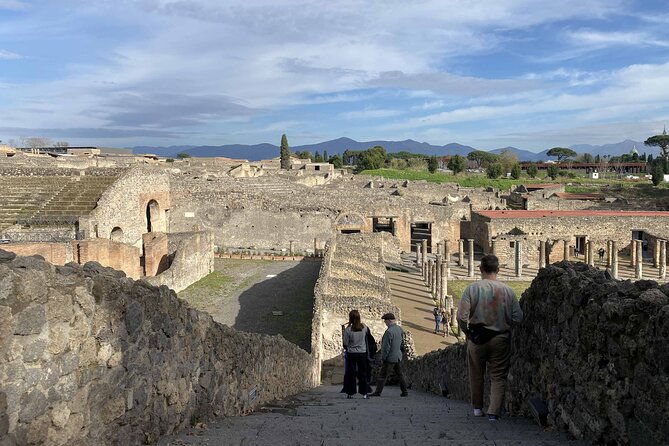
- Pompeii was a thriving ancient Roman city known for its bustling markets, theaters, baths, and temples before being destroyed by the eruption of Mount Vesuvius in 79 AD.
- The catastrophic eruption buried the city under meters of volcanic ash and pumice, killing approximately 2,000 people and preserving it for nearly 1,700 years.
- Excavations in the 18th and 19th centuries uncovered the remarkably preserved ruins of Pompeii, providing insights into the daily life and architecture of the lost civilization.
- Self-guided tours allow visitors to explore key sites, including the Grand Amphitheater, the Forum, the Lupanar (brothel), and the Villa of the Mysteries with its stunning frescoes.
- The rediscovery of Pompeii has revealed a captivating glimpse into the sophistication and social life of the ancient Roman Empire at its peak.
Pompeii: The Thriving Ancient City
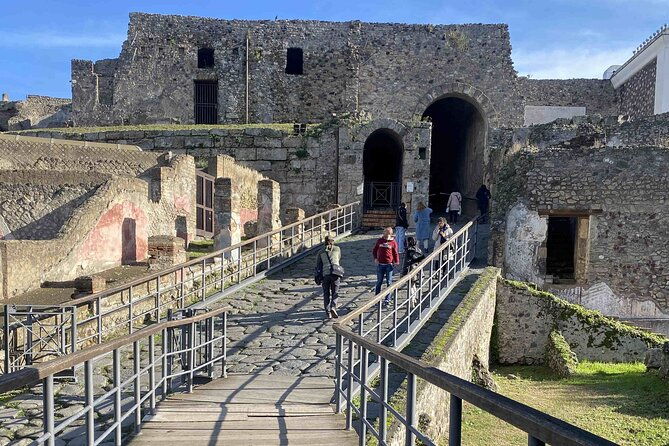
Pompeii was a thriving ancient Roman city situated at the base of Mount Vesuvius, a towering volcano in the Campania region of Italy. Founded in the 7th century BC, it was an important commercial hub, known for its bustling markets, theaters, baths, and temples.
Residents enjoyed a comfortable lifestyle, with access to running water, sophisticated plumbing, and elaborate frescoes adorning their homes. The city’s vibrant culture and architecture reflect the sophistication of the Roman Empire at its peak.
Tragically, in 79 AD, Mount Vesuvius erupted, burying Pompeii under layers of ash and pumice, preserving the city in time.
Here are more experiences we've reviewed in Pompeii
The Fateful Day: Mount Vesuvius Erupts
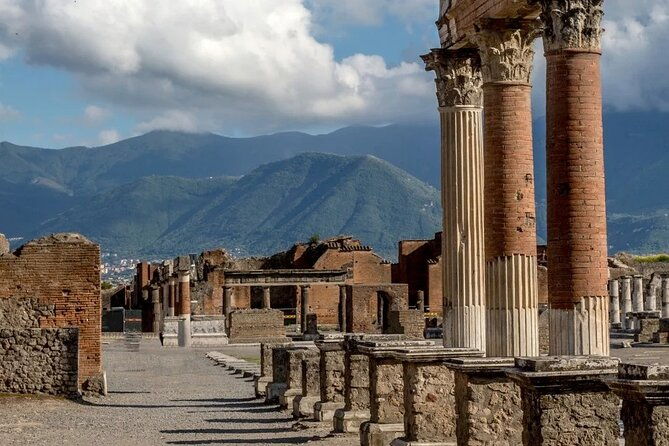
On the fateful day of August 24, 79 AD, Mount Vesuvius, a sleeping giant that had long dominated the Campanian landscape, suddenly erupted in a catastrophic explosion.
On August 24, 79 AD, Mount Vesuvius erupted in a catastrophic explosion, shattering the Campanian landscape.
The eruption unleashed a deadly pyroclastic flow – a superheated mixture of gas, ash, and rock – that swept through Pompeii at an estimated 450 mph. Within hours, the thriving city was buried under meters of volcanic ash and pumice, preserving it in time.
The eruption’s aftermath was devastating:
-
Approximately 2,000 people perished in Pompeii.
-
Entire neighborhoods were completely obliterated.
-
The city’s prosperous economy and vibrant culture were wiped out.
-
Pompeii remained lost for almost 1,700 years until its rediscovery in the 18th century.
Buried in Time: Uncovering the Ruins
Though Pompeii remained buried for centuries, excavations throughout the 18th and 19th centuries slowly uncovered this once-thriving Roman city.
Today, visitors can explore the remarkably preserved ruins and gain insights into daily life in ancient Pompeii. The site features intact structures, plaster casts of victims, and a wealth of artifacts that provide a window into the past.
With the self-guided tour, travelers can discover the Forum, amphitheater, brothels, and more at their own pace.
While much of Pompeii’s history remains shrouded, the excavated ruins offer a captivating glimpse into this lost civilization.
Exploring Pompeii’s Treasures
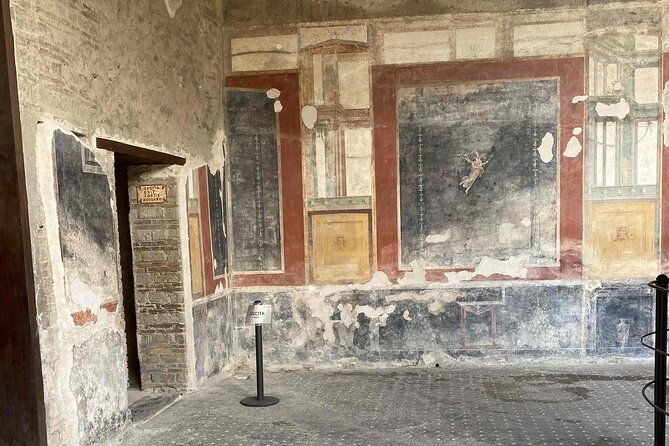
As visitors stroll through the remarkably preserved ruins of Pompeii, they’ll discover a treasure trove of artifacts and structures that offer a captivating glimpse into the daily lives of the city’s ancient inhabitants.
Highlights include:
-
The spectacularly detailed frescoes adorning the walls of villas and public buildings, showcasing the artistic prowess of Pompeii’s residents.
-
The well-preserved thermopolium, a fast-food restaurant where patrons can see the remnants of ancient dishes and serving counters.
-
The impressive amphitheater, once the site of thrilling gladiatorial contests and public spectacles.
-
The captivating plaster casts of victims, frozen in time by the volcanic eruption, poignantly illustrating the human tragedy of Pompeii’s demise.
Unraveling the Mysteries of Daily Life
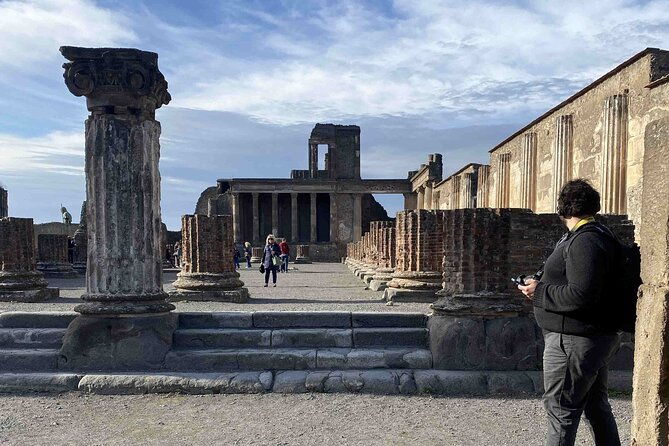
What secrets lie buried beneath the ash-blanketed streets of Pompeii?
Excavations have uncovered a wealth of details about daily life in this ancient Roman city. Homes, shops, and public spaces offer glimpses into the routines and pastimes of Pompeii’s residents.
Homes, shops, and public spaces offer glimpses into the routines and pastimes of Pompeii’s residents, as uncovered by excavations.
Examine frescoes depicting vibrant scenes, discover well-preserved carbonized loaves of bread, and inspect tools used in various trades.
Stroll through the forum, bathhouses, and amphitheater to envision the bustling activities and social interactions that once filled these spaces.
This self-guided tour allows you to unravel the mysteries of the past and learn about Pompeii’s captivating story.
Enjoying having a local guide? These other guided experiences in Pompeii might interest you
- Private Tour With Official Guide Through the Wonders of Pompeii.
- Skip the Line Guided Tour of Pompeii Led by an Archaeologist
- Pompeii Skip-The-Line Tour With Archaeologist Guide
- Pompeii Ticket With Optional Guided Tour
- Private Tour of Pompeii With Official Guide
- Pompeii Guided Tour & Horse Riding on Vesuvius With Lunch
Architectural Marvels of Pompeii
Pompeii’s architectural marvels continue to captivate visitors, showcasing the ingenuity and artistry of its ancient Roman builders.
Some highlights include:
-
The Grand Amphitheater: This iconic structure could seat up to 20,000 spectators and hosted thrilling gladiatorial contests and public events.
-
The Forum: The heart of Pompeii’s civic life, the Forum was surrounded by temples, markets, and administrative buildings, reflecting the city’s commercial and political importance.
-
The Lupanar: This well-preserved brothel offers a unique glimpse into the city’s vibrant social and cultural life.
-
The Villa of the Mysteries: The stunning frescoes in this opulent villa provide a window into Pompeii’s elite society and religious practices.
The Rediscovery and Preservation of Pompeii
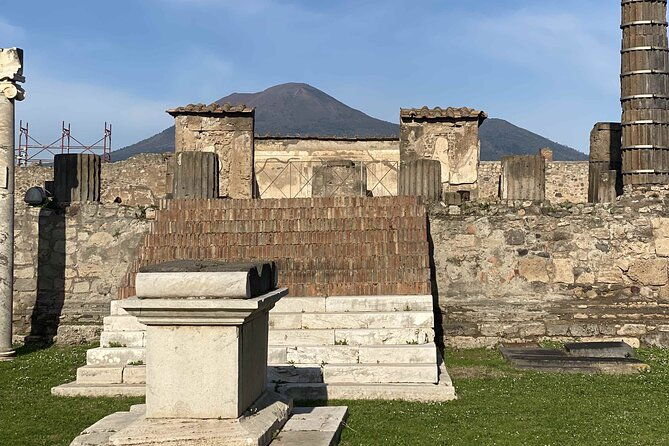
The rediscovery of Pompeii in the 18th century was a watershed moment, unlocking the secrets of this long-buried Roman city and captivating the world.
The rediscovery of Pompeii in the 18th century was a watershed moment, unlocking the secrets of this long-buried Roman city and captivating the world.
Excavations gradually revealed Pompeii’s remarkably preserved architecture, artworks, and everyday artifacts, offering unprecedented insights into ancient Roman life.
Today, the Pompeii Archaeological Park meticulously preserves these findings, welcoming visitors from around the globe.
Your self-guided tour allows you to explore this archaeological marvel at your own pace, guided by expert commentary.
Discover the city’s wonders, from the grand amphitheater to the intricately frescoed villas, and gain a deeper appreciation for Pompeii’s enduring legacy.
Planning Your Self-Guided Tour Experience
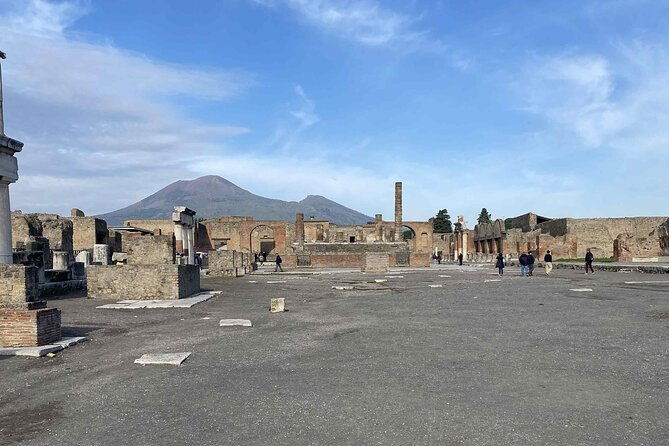
As you prepare to embark on your self-guided tour of Pompeii, a few essential planning steps will ensure a seamless and enriching experience.
First, download the VoiceMap app and purchase the tour, which provides offline access to the audio, maps, and geodata.
Second, familiarize yourself with the meeting point at the Marine Gate entrance and plan your transportation, whether by Circumvesuviana or Trenitalia regional train.
Third, confirm the tour’s start time in advance, as it may vary.
Finally, pack comfortable walking shoes and be mindful of the park’s open hours to make the most of your exploration of Pompeii’s ancient ruins.
Common Questions
Can I Join a Guided Tour Instead of Self-Guided?
Yes, you can join a guided tour instead of the self-guided tour. Many tour providers offer guided tours of Pompeii that allow you to explore the site with a knowledgeable local guide, rather than navigating it on your own.
What Is the Dress Code for Visiting Pompeii?
The dress code for visiting Pompeii is casual and comfortable. Visitors should wear lightweight, breathable clothing and comfortable walking shoes. It’s also a good idea to bring a sun hat, sunglasses, and sunscreen to protect against the Mediterranean sun.
Are There Any Nearby Accommodations for Overnight Stays?
There are many hotels, B&Bs, and vacation rentals near Pompeii that offer convenient accommodations for overnight stays. Visitors can easily find suitable lodging options within a short distance of the archaeological site.
Can I Bring My Pet to the Archaeological Site?
Pets are generally not allowed at the Pompeii Archaeological Park. The site has regulations in place to protect the ancient ruins and ensure the safety and enjoyment of all visitors. Visitors should plan accordingly and leave their pets at home.
What Is the Best Time of Year to Visit Pompeii?
The best time to visit Pompeii is during the shoulder seasons of spring and fall when the weather’s mild and crowds are smaller. Summers can be very hot, while winters may see some attractions closed.
More Private Tours in Pompeii
More Tours in Pompeii
More Tour Reviews in Pompeii
Still browsing? Here are more Pompeii experiences we've covered recently
- Pompeii’s 14 Top Tours (With Prices)
- 3 Must-Try Walking Tours In Pompeii
- Pompeii’s 14 Top Tours & Experiences (With Prices)
- What Are The Best Lunch Experiences In Pompeii? Our Top 3 Picks
- 3 Best 2-Hour Tours In Pompeii (With Reviews & Prices)
- Pompei Guided Tour at Sunset
- Private guided tour Of Pompei
- 2 Hours Private Tour of Pompeii for Journey Through Time
- Pompeii Visit at its Most Peaceful Moment
- Official Ape Dolce Vita Tour – Amalfi Coast
- Private Tour: Pompeii plus Herculaneum with Family Tour Option
- Mt. Vesuvius Wine Tasting and Lunch Experience from Pompeii
